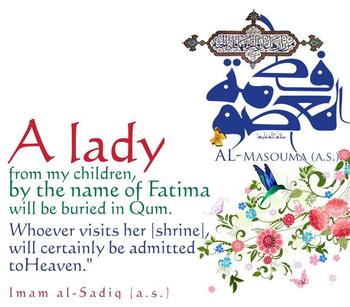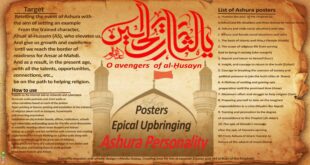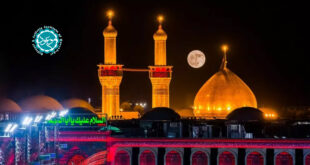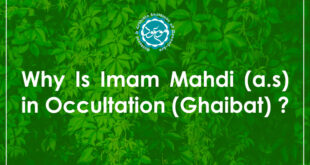The Holy Zarih (Burial Chamber)
In the year 965 A.H./1557 A.D., Shah Tahmasab Safavi made a Zarih (burial chamber) made of bricks which were covered with seven-colours tiles with glazed epigraphs. On all the four sides of the zarih there were openings through which the holy grave was seen and the pilgrims poured their offerings through them.
After some years Shah Tahmasab Safavi ordered for the construction of a zarih made of white and clear iron which was fixed to the zarih made of bricks.
In the year 1230 A.H./1814 A.D., Fath Ali Shah Qajar covered that iron zarih with silver. This zarih was corroded with the lapse of time. Thus, in the year 1280 A.H./1863 A.D., a new zarih was made of silver from the existing zarih and the silver preserved in the treasury of the holy shrine and placed on the grave.
That zarih was renovated many times and in the year 1969, a new zarih which is considered as a masterpiece of Islamic art was placed on the grave and that zarih exists till now. In the year 2001, basic renovation and repairs on the present zarih were carried out.
The Balconies in the Holy Shrine
The Golden Balcony
The golden balcony along with its two smaller balconies were constructed in the year 925 A.H./1519 A.D., when the dome was renovated and the Atiq courtyard and its minarets were constructed. At the top of the balcony an epigraph in blue background can be found on its circumference and in this epigraph the glorious hadith “Those who die with the love of the Family of Muhammad (peace be upon him and his household), die like the martyrs” is inscribed in thulth script.
After this epigraph the balcony’s two meters circumference is covered with intrinsic glazed tiles. After that, there is another epigraph on the circumference. Above it there is honeycomb network attached to the roof of the balcony which are covered with golden tiles.
There are two smaller balconies on its both sides and are covered with beautiful glazed tiles.
The Aineh (Mirror) Balcony
In the east of the holy shrine there is a big balcony and because of the mirror work carried out it has become known as the Aineh (Mirror) balcony. One meter of the wall from the floor is covered with marble stones and above it till the roof it is completely covered with intrinsic mirror work.
In the circumference of the balcony there is epigraph inscribed in thulth script on marble stones and the verse from the Holy Qur’an “Allah is the light of the heavens and the earth” is inscribed on it.
Between the balcony and the eastern porch of the holy shrine there is a small balcony which is completely covered with mirror work and on its entrance an inscription in Nastaliq script is engraved reading the holy hadith “Those who perform the ziyarah of Fatima (Masouma) in Qum will be granted heaven.” This wonderful artistic complex is the distinguished work of the famous master craftsman of the Qajari period Ustad Hasan Memar Qummi. This complex was built simultaneously with the construction of the new courtyard by the orders of the Prime Minister of that period Mirza Ali Asghar Khan Atabeg.
The Minarets in the Holy Shrine
Atiq Courtyard’s Minarets In the Atiq courtyard two minarets are located on the Golden (Tila) balcony. The surface of the minarets is covered by knotted tiles in zigzag form and the holy names Allah (SWT), Muhammad (peace be upon him and his household) and Ali (AS)’ are inscribed in between these knotted tiles.
These minarets were built on the orders of Muhammad Husain Khan Shahsavan Shihab al-Mulk in the year 1285 A.H./1868 A.D., and its domes were covered with golden tiles in 1301 A.H./1883 A.D.
The Minarets of the Mirror Balcony
On both the sides of the bases of the balcony two minarets are located which are considered as the highest building in the holy shrine.
At the top of the minarets there are two inscriptions written on an epigraphs with a breadth of one meters. Both these minarets are fully covered by knotted tiles and in between them the Holy Names of Allah (SWT) are written.
The Minarets of the Grand Courtyard
Two minarets are also found in the grand courtyard of the holy shrine which is also famous as Atabeg or Nau courtyard. They are located opposite to the mirror balcony. Till recently the A’zaan and Supplications were recited from the top of the minarets. These minarets are decorated and has given special beauty to this courtyard.
The Mosques in the Holy Shrine
Balasar Mosque
Balasar mosque is considered as the most beautiful portico in the holy shrine where religious functions and congregational prayers are performed. During the Safavid era it was the inn of the holy shrine but during the Qajar period it was developed into a mosque with two big domes. This portico is also considered as the largest roofed building of the holy shrine.
In the year 1338 A.H./1919 A.D., the land lying on the western side of the mosque was included in the mosque thus increasing the area of the mosque.
After the construction of the Masjid-i Azam the Balasar mosque was positioned between the holy burial chamber and the Masjid-i Azam. The old structure of the mosque was renovated completely and the present mosque was constructed. The present building of the mosque was built based on special patterns of Islamic architecture and is considered as one of the grand buildings of the holy shrine.
Tabatabai Mosque
Tabatabai mosque has a dome placed on fifty columns. It was built in the place of the old Zenana courtyard in the southern part of the holy shrine.
The founder of this mosque which consists of a grand dome was Hojjat al-Islam Haj Agha Muhammad Tabatabai, the son of late Ayatullah Haj Agha Husain Qummi and was constructed between the years 1360-1370 A.H./1941-1950 A.D.
Shaheed Mutahhari Mosque
This mosque was built in the place of the former museum of the holy shrine. The building of the mosque is beautifully decorated with intrinsic tiles and most of the religious functions are held in this mosque.
A Reminder:
These buildings which are called as mosques are mosque only in name and the laws of the mosques are not applicable to them.
Thus many grand Ulama, Marajah and other people are buried in these places.
In the holy shrine the below-mentioned two places have the status of a mosque.
1. The area in front of the mihrab (niche) of Tabatabai mosque.
2. The area attached to the upper side of the burial chamber of Hadrat Masoumah (AS).
Afterwards the whole area around these two places was called as mosques.
Porticos
The covered buildings attached to the holy burial chamber are called as portico (riwaq).
 Mouood Mouood English Edition
Mouood Mouood English Edition




